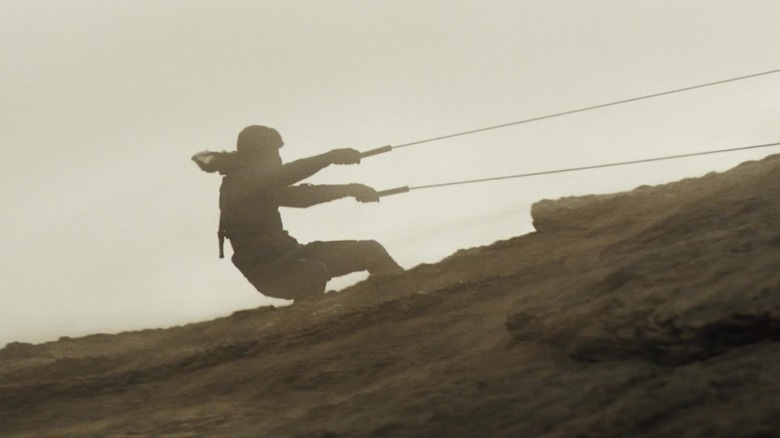How Dune 2 Meticulously Brought Paul Atreides' First Sandworm Ride To Life
We may receive a commission on purchases made from links.
"Dune: Part Two" is a masterpiece of blockbuster cinema, a bleak spectacle of doom about the dangers of messianic myths, a grand scale story with some of the best-looking set pieces of the past year. As far as adaptations of Frank Herbert's book goes, this is the best one.
A big highlight of the film is the moment Paul Atreides finally rides his first sandworm, fully becoming one of the Fremen and unlocking a giant and intense desert Uber system. As impressive as the moment is on the screen, it only happened due to meticulous work behind the scenes. The book "The Art and Soul of Dune: Part Two" by Tanya Lapointe and Stefanie Broos, details how the three-minute scene was made using over 60 shots filmed over a period of two months.
To bring the worm to life necessitated a 90-foot-long by 24-foot-wide set piece, divided between different pieces for different shots. There were two platforms to look like the back of a sandworm, covered with sand-colored elephant-skin texture, with a middle section made of foam where the stunts would happen. There was also a rig on a motion base that could stimulate the worm's movements, and a 65-feet texture for the wide shot of Paul first hooking onto the worm. These hooks are important, because, as Denis Villeneuve explained in the book, "When you pull up a section of the skin with a hook, you are revealing a vulnerable part of the worm. You're exposing its vents, and the worm wants to protect itself from getting sand beneath this sensitive under-skin." This skin was also built practically into the rigs, and animated by the special effects team on set so the skin lip could be lifted to reveal the vents.
Bless the maker and his water, for building a sandworm isn't easy
To bring the worm riding scene to life, a dedicated "Worm Unit" was put together, and they developed a lingo to explain the movements the motion base would use for worm riding, like "easy weaving" describing smooth side-to-side slalom, or "school bus bump" to make Paul bounce off the worm — cinematographer Greig Fraser set up an "ascender rig" that would make the camera move upward at around 23 feet per second, which worked to simulate Paul's descent once the worm starts going down a sand dune.
In order to capture the movements of the worm and the danger Paul is in as the worm goes from moving vertically to horizontally, there was a smaller worm platform, with worm skin installed on a gimbal that would roll sideways as if to shake Paul off, and tilt to simulate the worm going up a dune or picking up speed. To illustrate the shift of the worm going from a vertical to a horizontal moving pattern, Villeneuve wanted Paul to slip and be left hanging in midair off the worm's side for a brief moment. Accomplishing this required the special effects team to build a hinge for the rig — which is normally positioned at a 45-degree angle — so it could go beyond 90-degrees to bring Paul airborne, then go back to 70-degrees and create the impression of the worm slamming down.
As impressive as the worm riding looks on screen, and as essential as it is for Fremen culture, it does leave some big questions unanswered, such as how exactly the Fremen get off the sandworms.

